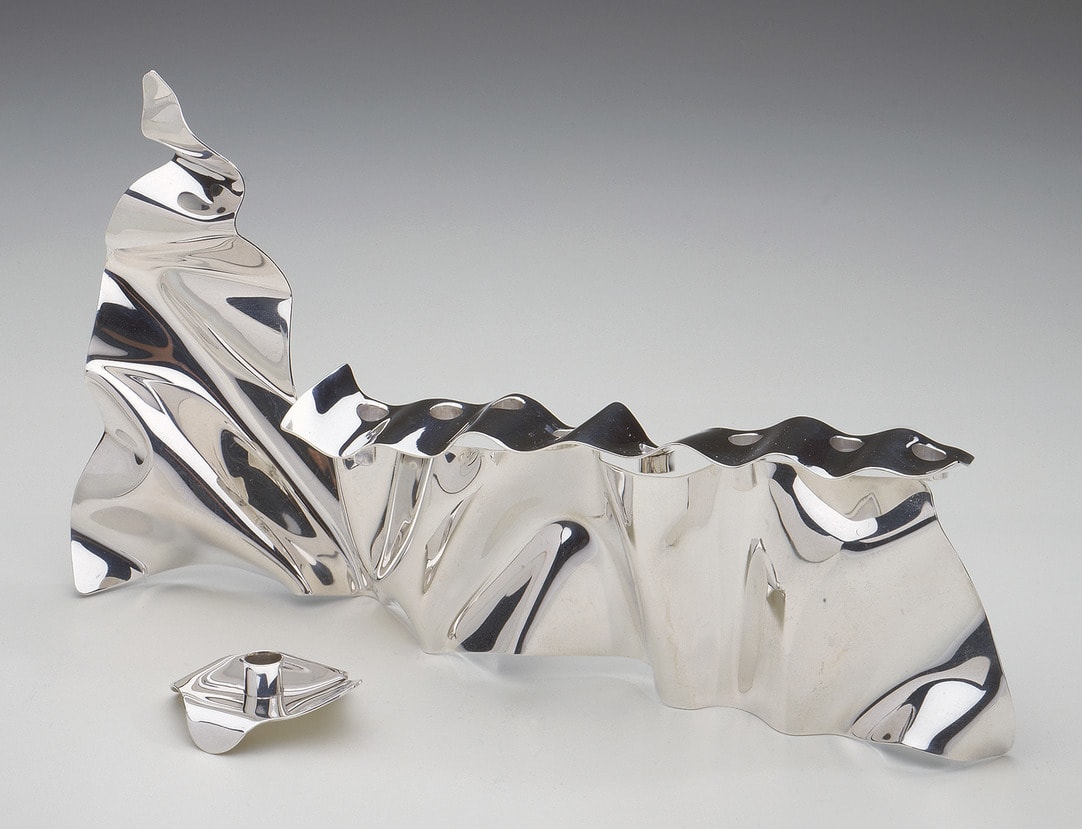
- Object Name:
- Hanukkah Lamp
- Artist/Maker:
- Moshe Zabari
- Bio:
- b. 1935, Jerusalem; d. 2025, Israel
- Title:
- Masada
- Place Made:
- New York, United States
- Date:
- 1968
- Medium:
- Silver: hand-worked and embossed
- Dimensions:
- 6 3/4 × 11 3/4 × 1 9/16 in. (17.1 × 29.8 × 4 cm)
- Credit Line:
- Gift of the Albert A. List Family
- Accession Number:
- JM 253-68a-c
On View
For almost thirty years, Moshe Zabari was director and artist-in-residence at the Tobe Pascher Workshop in The Jewish Museum. The workshop was a center for the encouragement of the finest contemporary design, as well as an actual silversmithing studio within the walls of the museum. Zabari’s tenure there marked a rich period in the development of contemporary Jewish ceremonial art.
Zabari, the son of a Turkish mother and a Yemenite father, was brought up in an Orthodox Jewish household, where studying and participating in the rituals and observances of a traditional home were a vital part of his life. In 1955, after his release from the army, Zabari entered the Bezalel Academy of Art and Design in Jerusalem, where he studied with some of its most influential artists including David Gumbel and Ludwig Y. Wolpert. Their theories were infused with the teachings of the Bauhaus and the International Style, and exerted a lasting influence on Zabari. A bold reduction of form and overall simplicity characterize his style and reflect the mentorship of his illustrious teachers. Hebrew letters, both as decoration and as structural components, are key elements to his work, and he developed a particular fascination for incorporating ancient texts and proto-Hebraic lettering in his pieces.
Zabari’s Hanukkah lamp entitled Masada is composed of hammered sheets of silver that take on the actual shape of the isolated rock on the edge of the Judean Desert. The rippling surfaces give the piece a highly charged vivacity and energy analogous to the fire of the Festival of Light itself. Masada links two great events of Jewish history: the triumph through martyrdom of the Jewish zealots at Masada in 73 C.E. and the victory of Judah Maccabee over the Greeks in 164 B.C.E. The inspiration to create this Hanukkah lamp came from an exhibition on Masada held at The Jewish Museum in 1967.
Zabari, the son of a Turkish mother and a Yemenite father, was brought up in an Orthodox Jewish household, where studying and participating in the rituals and observances of a traditional home were a vital part of his life. In 1955, after his release from the army, Zabari entered the Bezalel Academy of Art and Design in Jerusalem, where he studied with some of its most influential artists including David Gumbel and Ludwig Y. Wolpert. Their theories were infused with the teachings of the Bauhaus and the International Style, and exerted a lasting influence on Zabari. A bold reduction of form and overall simplicity characterize his style and reflect the mentorship of his illustrious teachers. Hebrew letters, both as decoration and as structural components, are key elements to his work, and he developed a particular fascination for incorporating ancient texts and proto-Hebraic lettering in his pieces.
Zabari’s Hanukkah lamp entitled Masada is composed of hammered sheets of silver that take on the actual shape of the isolated rock on the edge of the Judean Desert. The rippling surfaces give the piece a highly charged vivacity and energy analogous to the fire of the Festival of Light itself. Masada links two great events of Jewish history: the triumph through martyrdom of the Jewish zealots at Masada in 73 C.E. and the victory of Judah Maccabee over the Greeks in 164 B.C.E. The inspiration to create this Hanukkah lamp came from an exhibition on Masada held at The Jewish Museum in 1967.
Information may change as a result of ongoing research.